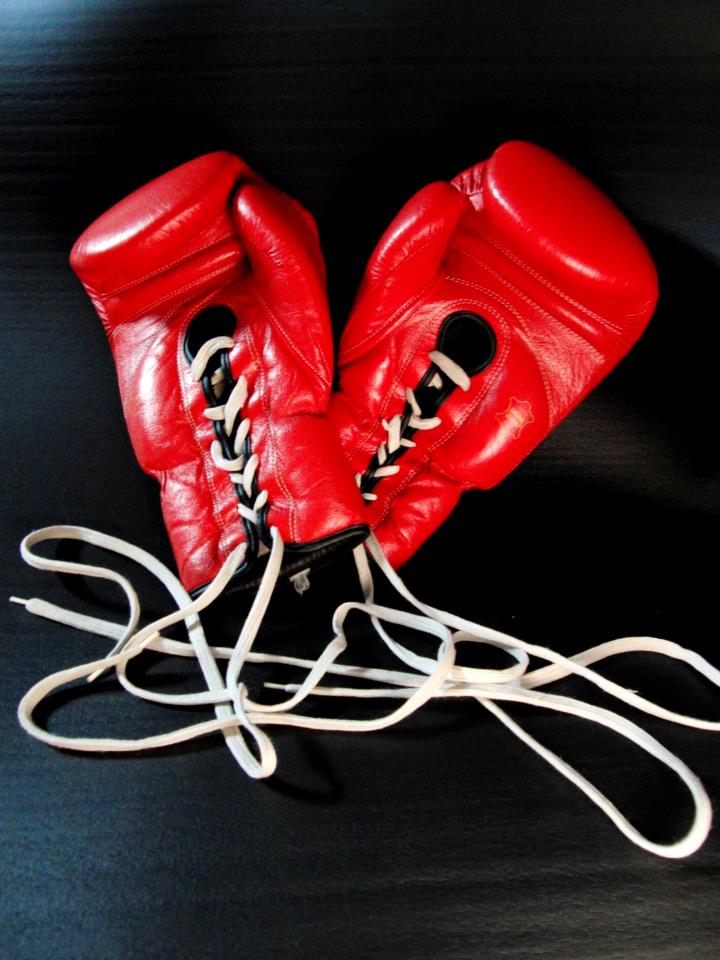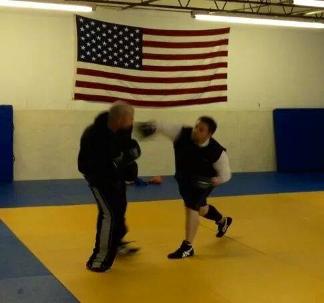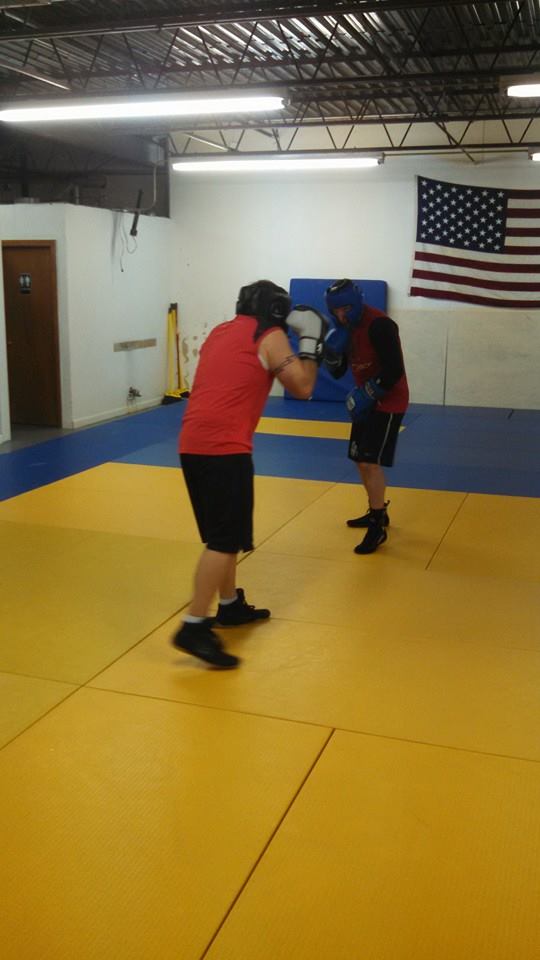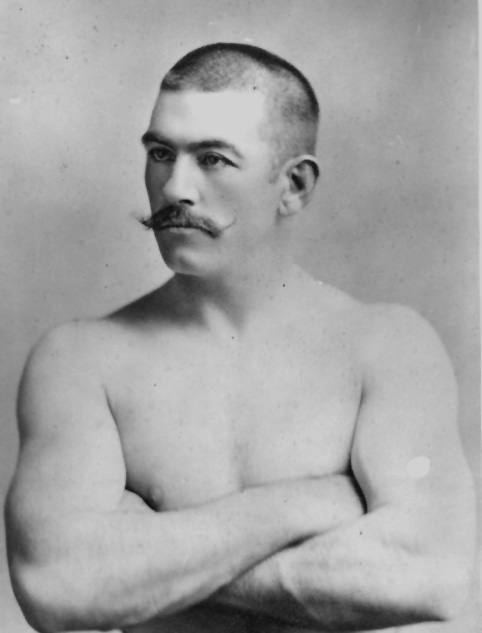
Boxing As Self-Defense
Learning how to box enhances one's ability to better absorb punches, avoid punches through practical defensive maneuvers, and counter-punch with accuracy & power. These skills can often intimidate aggressors instantly, and end unavoidable physical altercations quickly & efficiently. Grappling, submission holds, and ground-fighting are all valuable skills. But if outnumbered on the street, it is far from ideal to be wrestling an attacker on the ground, giving other enemies the chance to stomp & strike while you are entangled & vulnerable. The ability to fight on your feet, and to be proficient in striking is key to ending altercations quickly. Boxing is one of the best ways to learn such skills.

Instructor Kevin (left) sparring at a previous location with past client Tony who went on to compete at the renowned Haymakers For Hope charity boxing event, as his first competitive boxing match.
The Importance of Sparring
Once fundamentals are learned, the instructor introduces sparring drills, and gradually, sessions are filled with more and more time sparring with the instructor, starting very light, and very gradually increasing in intensity over time as comfort builds. Our regularly meeting open sparring group consists of the instructor and past & present students of varying levels of boxing experience all working together doing full-contact sparring. These sessions are the best way for students who have learned the fundamentals to have a chance to stay sharp & keep in shape, while developing more advanced skills, technique & conditioning in a friendly but competitive environment.
Like pick-up games in basketball or scrimmages in baseball, sparring is competitively boxing, with the goal of improving the skill, timing and conditioning of participants. An inevitable side-effect of regular full-contact sparring is increased "toughness", or ability to withstand getting hit with more significant force with less traumatic effect on you. If you've never really been blasted with a punch (most notably in the face), the first handful of times can be very jarring, and can literally cause you to forget everything, panic, and immediately want to stop to assess yourself for damage. Getting used to hard shots getting through your guard from time to time will dull this effect, making you much more proficient at intelligently defending yourself when it happens. Just like doing any actual activity full-force, full speed, is the best way to improve at that activity, boxing is no different. Sparring is the only way to ultimately really learn how to box, and no amount of other types of training can replace the benefits of actual sparring for the student who really wants to learn.
Boxing Through The Years
Affectionately known as the "sweet science of bruising", boxing is a sport and martial art with ancient beginnings. With evidence throughout history such as Sumerian relief carvings from the 3rd millenium BC depicting a fistfight, it is safe to say that boxing, at least in its most basic form, is not without deep roots. Over the years, boxing's rules have evolved greatly. A major development came in 1867, when the Marquess of Queensberry Rules were drafted, which are considered the origin of the modern sport of boxing, most notably the use of gloves. The ring, known as the "squared circle of combat" is the modern stage for boxing as competition.
At 13 Strikes Boxing & Fitness, we are among the biggest boxing fans around, and we seek to share our passion by teaching our clients everything we know about this sport that we love. We take great pride in our boxing instruction, and our students can be confident that they will acquire strong fundamentals, great conditioning & advanced technique in boxing.
Our Boxing Programs
-Private 1-on-1 sessions allow the instructor to give complete, undivided attention to the student, with privacy eliminating any self-consciousness one may have about learning unfamiliar skills. The first intro session costs just $20, no strings attached. To continue training, various factors determine price per session, but typically price ranges from $50-$80 per session.
-Multiple-client sessions allow clients to privately train in small groups of chosen partners, be it family, co-workers, or friends. Having partners to train with can make training more fun, and can add some friendly competition into the mix. Clients may train with as many as 5 total people in their private session. Don't be shy! Spread the word about our group rates, because for multiple-client sessions, the total cost per session goes up only $20 per student!
-Open sparring sessions typically occur regularly on weekend mornings, involving light-to-full-contact sparring between the instructor and a pool of past & present students if various experience levels. Students are invited to the sparring group once they have demonstrated a high enough level of discipline, sportsmanship & fundamentals. This sparring group is great because it offers more advanced students continued development in their boxing skills and conditioning, and is free for past and current private training clients!
-Youth boxing offers training & lessons to children, ages 12-17. Children younger than 12 years old are encouraged to train along with their parents for the same cost as regular 1-on-1 sessions. Boxing is an excellent sport to learn at a young age to teach a child practical self-defense and to build confidence. Youth boxing lessons are private by appointment just like adult boxing lessons, and pricing is the same. Parents/guardians of young students are always welcome to stay to observe and/or participate in the private sessions.
Class Procedure
Each private session lasts 1 hour. Every session starts with a warm-up (usually jump rope), and dynamic stretching. Guided shadowboxing, mittwork, work on bags, drills and sparring make up the bulk of training sessions. For students with no boxing background, basic fundamentals & conditioning are the primary points of focus in the beginning. As basic skills & fitness develop, advanced technique & competitive strategy play a larger role in the program, at which point sparring rounds with the instructor is typically the primary focus of sessions.
When the instructor feels the student is ready, incorporating sparring into the program is strongly suggested, but is always optional. Sparring with beginners always starts with very light, controlled contact from the instructor during the sessions, with the student having the freedom to throw as hard as they want, while keeping a focus on proper form & balance, as well as keeping in mind whatever fundamental lessons that are being focused on at the time. As the student improves, sparring will typically progress with incrementally harder contact as tolerated, and eventually even sparring with other students in the open sparring group, if desired. Safety is our first priority, and all sparring is closely supervised, with good sportsmanship & improvement for both parties being the goals of every sparring session between students.


John L. Sullivan, "The Boston Strong Boy" - widely recognized as the first Heavyweight Champion of the World, America's first sports hero,from nearby Lawrence, MA.
Two long-time clients: Ron & Craig, who both went on to train at boxing gyms, & Craig has since competed in a numerous bouts.
Kevin R. Gerstel, CSCS
617-571-6341